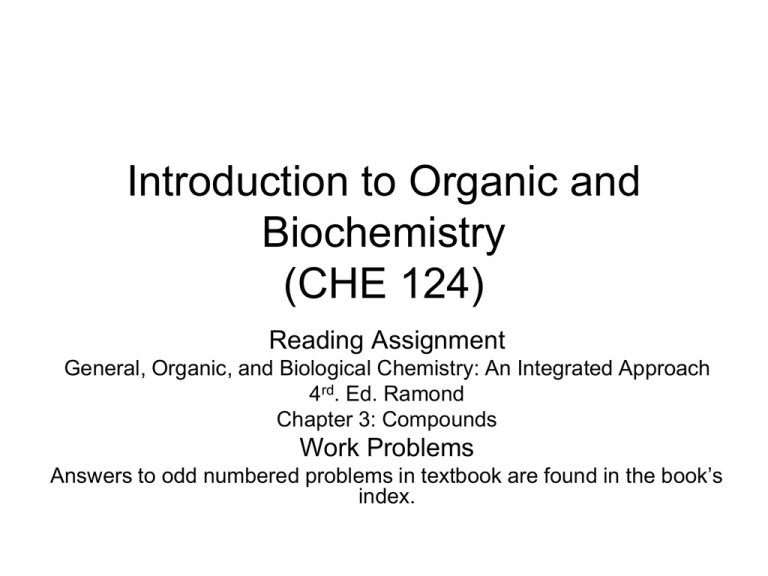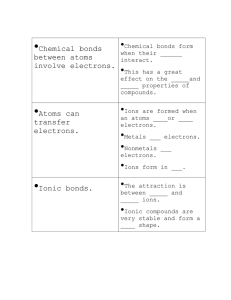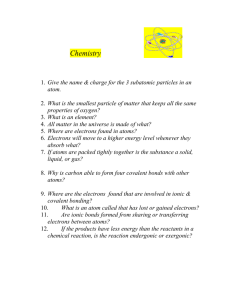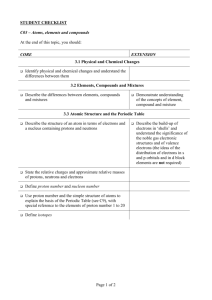Introduction to Organic and Biochemistry (CHE 124) Reading Assignment
advertisement

Introduction to Organic and Biochemistry (CHE 124) Reading Assignment General, Organic, and Biological Chemistry: An Integrated Approach 4rd. Ed. Ramond Chapter 3: Compounds Work Problems Answers to odd numbered problems in textbook are found in the book’s index. Compounds / Ions • Matter (Ch. 1) – anything that has mass and occupies space. • Atoms (Ch. 2) – The building block of matter. • Element (Ch.2) – Substance that contains only on type of atom. – cannot be broken down into substances with different properties by chemical means. • Compound – Matter constructed of two of more chemically combined elements. • Ion – A charged atom or group of atoms produced due to the loss or gain of electrons. • + ions are called cations • - ions are called anions Ions • How many protons, neutrons and electrons does (uncharged) Na (sodium) contain. • What information do we need? Where is this information? --- Period table. • Na number 11 means 11 protons and 11 electrons. Symbol Protons Electrons Charge Name Na Na+ 11 11 11 10 0 1+ Sodium Sodium ion Ca Ca2+ 20 20 20 18 0 2+ Calcium Calcium ion Polyatomic Ions • Polyatomic ions – Ions composed of two or more atoms. These atoms behave as a single unit. • NH4+ Ammonium ion • OHHydroxide – See Sheet with monatomic and polyatomic ions. Octet Rule • Octet Rule – Atoms gain or loss or share valence electrons in order to end up with 8 valence electrons. – 8 electrons in the valence shell is a stable electron arrangement. • Helps to explain ions and covalent bonds. – Nonmetals gain electrons. – Metals loss electrons. • See table 3.3 p 80 – The noble (inert) gases are unreactive because they contain 8 electrons in their valence shell. • Draw Figure 3.2 p. 79 on the board. Ionic Compounds • Compound – Matter composed of two or more elements in a fixed proportion. • Ionic Compound – A compound composed of a cation and an anion. – Ionic compounds form ionic bonds. – Sodium Chloride Na+ ClNaCl • Table salt – Magnesium Chloride Mg2+ Cl- MgCl2 • Used as magnesium supplement (Slo-Mag) • Some ionic compounds contain polyatomic ions – Sodium Sulfite Na+ SO3 2- Na2SO3 Mg2+ OH- Mg(OH)2 • Food preservative – Magnesium hydroxide • Milk of Magnesia - laxative – Charge must balance. Physical vs Chemical • Physical Properties – A characteristic of matter that does not involve varying its chemical composition. • Chemical Properties – Chemical changes that an element or a compound undergo. • Physical Change – A change in matter that does not involve varying its chemical composition. • Chemical Change – A change in matter that involves changing its chemical composition. Nomenclature of Ionic Compounds • Name cation followed by name for anion – Do not specify number of times the cation or anion appears in formula. • • • • BaSO4 CaCO4 AgNO3 Sodium hydroxide Barium Sulfate Calcium Carbonate Silver Nitrate NaOH • For Transition Metals (more than one oxidation state). – Designate the oxidation state using a Roman numeral. • CuCl • CuCl2 Copper (I) chloride Copper (II) chloride Cuprous chloride Cupric chloride – See table 3.4 p. 84 • YOU MUST KNOW THE INFORMATION ON THE HANDOUT OF ELEMENTS, MONOATOMIC IONS, AND POLYATOMIC IONS Covalent Bonds • Covalent Bonds – a bond formed by two atoms sharing a pair of valence electrons (one electron from each atom). – Nonmetals form covalent bonds. • Draw the Lewis dot structure for two Fluorine – Covalent bond symbolized by a line (represents a pair of shared electrons.) – See figure 3.9 p. 85 ELEMENT # Covalent DRAW Bonds Hydrogen 1 Oxygen 2 Nitrogen 3 Carbon 4 Phosphorus 5 Covalent Bonds (Cont) • Some elements form double or triple covalent bonds by sharing two pairs or three pairs of electrons. – Draw Lewis dot structure and line structure for molecular oxygen (O2), which forms double bonds. – Draw Lewis dot structure and line structure for acetylene (C2H2), which contains a triple bond. Molecules • Molecules – Uncharged group of atoms connected to one another by covalent bonds. • Draw electron dot and line-bond method for the compounds water (H2O), Hydrogen fluoride (HF), ammonia (NH3), Methane (CH4) – Some molecules are elements because they contain just one type of atom • Diatomic elements H2, N2, O2, F2, Cl2, and I2 • Triatomic elements O3 Nomenclature of Binary Molecules • Binary Molecules – Molecules contain two different elements. • 1. Name elements in order of appearance. • 2. Drop the ending from the second element and add ide. • 3. Add prefix to denote # of atoms of an element 1 Mono 6 Hexa 2 Di 7 Hepta 3 Tri 8 Octa 4 Tetra 9 Nana 5 penta 10 deca Try naming these HF, CaCl2, CO, CO2, SO2, SO3 Calculating Formula Weight • Formula Weight – Sum of the atomic weights of the elements in the formula. – Units are amu OR g / mol • Molecular Weight – Sum of the atomic weights of the elements in the molecular formula. – Units amu OR g / mol • What are the Formula / Molecular Weight of the species below? – – – – NaCl H2O Cu(NO3)2 C6H12O6 (Glucose) • Demonstrate the systematic approach. Typical Problem • What is the mass of 1.5 moles of glucose (C6H12O6)? • What is the mass of 2.50 mol of chloroform (CHCl3) Nitric Oxide (aka Nitrogen Monoxide) • Nitric Oxide (NO) – Nitrogen bonded to Oxygen through a double bond. – Colorless gas that has minimum effect on health. – Unusual because it does not contain an octet. • Atmospheric Pollutant – Colorless gas produced by engines during combustion. – Reacts with water (along with NO2) to produce acid rain. • Nitrogen dioxide is a brown gas that increases risk of asthma and other lung problems • Second Messenger in cellular signaling. – Nitric oxide is a powerful vasodilator. • Regulates blood pressure, controls muscles that dilate arteries and blood vessels. • Nitric oxide is produced when nitroglycerin is placed under the tongue.




